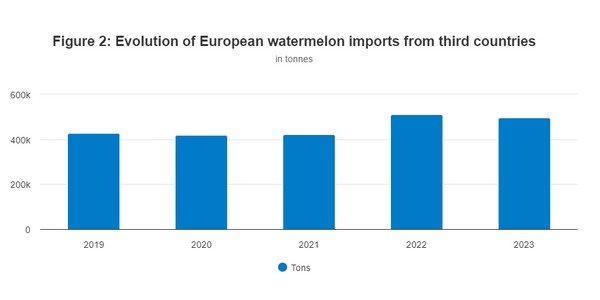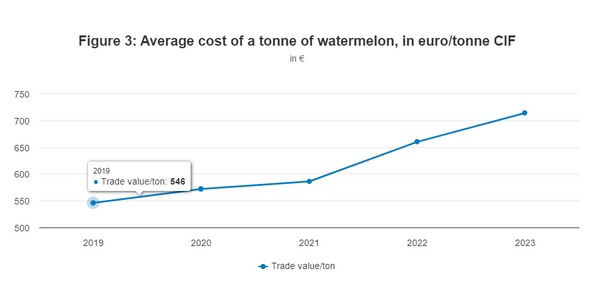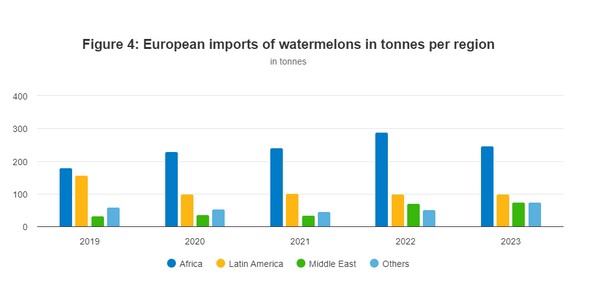Watermelons are mostly found in Europe during the warmer months, from spring to autumn. People enjoy eating them as a refreshing snack or using them in fruit salads, smoothies and desserts. They are also popular at picnics and barbecues due to their high water content, keeping you hydrated on hot days. There is also an off-season demand for watermelon (in winter or at the very beginning of spring). Although this is limited, it also offers an opportunity in certain European markets. The European watermelon market is steadily growing and is expected to continue growing in the upcoming years, especially with the rise in temperatures during spring and autumn. Spain, Italy and Greece are Europe's main watermelon producers.
Product description
Watermelons (scientific name: Citrullus lanatus) are part of the Cucurbitaceae family. They are big, usually round or oval, with a thick green rind that has light or dark stripes. However, there is a wide range of varieties – each with its own features in terms of size, shape, colour, flavour and texture. The flesh can be red, yellow, orange or even white, depending on the variety. Watermelons are categorised under HS code 08 07 11 00 in the Harmonised System.
A strong demand that relies on imports
Despite Europe's strong production of watermelons (almost 3 million tonnes in 2023), the European market still relies heavily on imports to meet its needs. Over the past five years, volumes of watermelon imports have risen steadily, from 428,000 tonnes in 2019 to 496,000 tonnes in 2023. This is an increase of almost 16%. The watermelon market continues to develop thanks to the wide range of varieties marketed.
Watermelons are widely offered on major markets in Europe, but they can also be found in niche markets, organic markets and speciality product markets. As watermelon comes in various types and can be used in different ways, it appeals to both broad and specialised market sectors, allowing producers and retailers to target a diverse variety of consumers.
A steady rise in the cost (CIF) of watermelon imports
Over the past five years, the cost of watermelons imported from third countries has continuously increased.
As a supplier of watermelons to the European market, you must bear in mind that it is a very competitive and selective market. If you target a speciality market, your products will need to be of optimum quality to allow you to gain market shares. European buyers' interest in organic products continues to rise and this is a way for you to establish yourself on this very selective market. Varieties with flesh colours other than red, as well as seedless ones, can also be a way for you to stand out from what is already available in mainstream markets.
Watermelons are mainly imported into Europe by sea or by road, which are both very cost-effective means of transportation. The average cost of a tonne of watermelon imported from non-European countries has steadily risen since 2019. In 2019, the average cost (Cost, Insurance and Freight – CIF) of a tonne of watermelon was €546/tonne. In 2023, this cost was €714/tonne, which represents an increase of a little more than 30%
Complementary imports mainly come from Africa
Watermelon production is seasonal in Europe. In general, the first European fruits from open-air production go on sale in May/June. Imports of watermelons from other regions start at the beginning of April, or even at the end of March. Thanks to production in greenhouses, some European countries are starting their watermelon campaigns earlier and earlier (mid-April for Spain and late April for Italy).
The main imports of watermelons outside the European Union come from Africa (mainly Morocco), followed by Latin America (mainly Costa Rica) and finally the Middle East (mainly Turkey).
In 2023, the European market imported 50% of its additional volumes of watermelons from Africa, 20% from Latin America and 15% from the Middle East.
For more information:
CBI
P.O.Box 93144
2509 AC The Hague
The Netherlands
Tel: +31 (0)88 042 4300
Email: [email protected]
Website: www.cbi.eu



